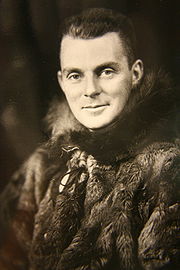Punch Dickins
| Clennell Haggerston "Punch" Dickins | |
|---|---|

Clennell Haggerston "Punch" Dickins c.1927
|
|
| Born |
January 12, 1899 Portage la Prairie, Manitoba, Canada |
| Died | August 3, 1995 (aged 96) Toronto, Ontario, Canada |
| Occupation | Aviator, salesperson, and spokesperson |
| Spouse(s) | Connie Dickins |
| Children | 3 DREp |
Clennell Haggerston "Punch" Dickins OC OBE DFC (January 12, 1899 – August 2, 1995) was a pioneering Canadian aviator and bush pilot. Northern native Americans called him "Snow Eagle;" northern Europeans called him "White Eagle;" while the press dubbed him the "Flying Knight of the Northland."
Clennell Haggerston Dickins was born in Portage la Prairie, Manitoba and moved with his family to Edmonton, Alberta in 1909, when he was ten years old. The nickname, "Punch" came at an early age, reputed to be either when his brother, Francis, first called him Punch, according to Punch's son, John. Other reports say his maternal Aunt Nell dubbed him a fat little punch because his clothes wouldn't stay over his tummy. In interviews in later years, Dickins said he was not sure how he acquired the nickname, but admitted he had it longer than he could remember.
Punch went to Peace Avenue school, a temporary school. In 1914 when he was 16, he enrolled in mechanical engineering at the University of Alberta, but when war broke out he quit to enlist as an infantryman in the Canadian Army, and served with the 196th Western Universities Battalion for one year as a company clerk. While in Europe he transferred to the Royal Flying Corps. Punch transferred from the 21st Reserve Unit to the RFC School of Instruction at the Acton Aerodrome, northwest of London.
Punch became a bomber pilot and served with No. 211 Squadron, Royal Air Force, flying from the front line base at Petit Synthe, France. Serving from May 1918 until February 1919, Punch emerged as a skilled and able pilot of the Airco DH9 medium bomber. It was claimed he eventually shot down seven enemy aircraft, earning the distinction of being one of the few bomber pilots to become an ace. What is certain is that he and his gunner claimed an enemy aircraft that broke up on 4 November 1918 (shared with 2nd Lt W G Watson/Sgt. C Lamont). He attributed his success to having a skilled gunner, 2nd Lt. Jock Adam, and the pair of them worked as a team. Dick and Adam would complete 73 missions by the end of the war. Punch was awarded the DFC (Distinguished Flying Cross) at age 20 in 1919. The dispatch that accompanied the award noted that 2nd Lt. C.H. Dick had completed aerial assignments under fire with "persistence and gallantry.".
...
Wikipedia
